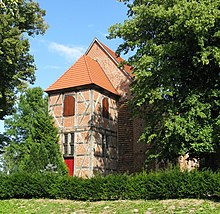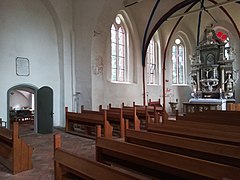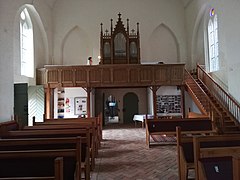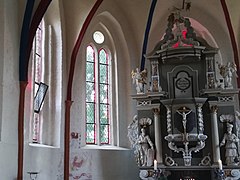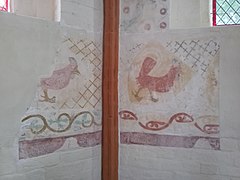Bibow village church
The village church Bibow is an Evangelical Lutheran church building in Bibow , a municipality in the district of Northwest Mecklenburg in Mecklenburg-Western Pomerania . It belongs to the Bibow parish in the Wismar provost in the Mecklenburg parish of the Evangelical Lutheran Church in Northern Germany .
history
Around the middle of the 14th century a squire Hardenack lived in Bibow, whose family is identical to that of Bibow . Bibow was first mentioned as a parish in 1372. Johann von Plessen was already sitting on Gut Neuhof at that time. What may have given rise to the legend that later appeared that the church in Bibow was one of those seven churches that was once founded by Helmold von Plesse , the progenitor of the Mecklenburg von Plessen, cannot be identified from the documents of that time. It is assumed that the church was founded by the von Bibow family, because the von Bibow family also bear their name from the knight's arm of the Bibow estate near Warin .
Because when Hardenack von Bibow had lent all goods of Gottschalk von Preen , including Bresen, Ventschow , Thurow , Jesendorf and Bibow, for himself and his family, to Johann von Bassewitz, 1444 Duke Heinrich von Mecklenburg , also known as Heinrich the Fat , in 1450 Having asserted claims to Bibow, the Duke explicitly recognized in 1467 that the latter also held the parish of Bibow in addition to all other rights. It was not until 1510 that Heinrich von Plessen became the lien owner of Bibow after Hardenack von Bibow on Westenbrugge had ceded his share in Bibow and Ventschow to von Plessen with the approval of the dukes. These remained in Bibow's possession for a hundred years. In 1611 it was pledged to Detlev von Warnstaedt , in whose possession Bibow remained until 1672. This year, the church's patronage rights are passed to District Administrator Bogislav Ernst von Pederstorff . In 1702 Bibow was again in von Plessen's hands and in 1703 it belonged to Captain Jerimias von Behr. From 1721 to 1744 the Dobbertin monastery also sued Hauptmann von Behr for large debts. In 1744 Detlof Hans von Bassewitz acquired von Behr's bankruptcy estate at Neuhof and it remained in the family's possession until 1824. The legal successors then changed at shorter intervals.
Building description
Exterior
The high-Gothic brick building from the 1st half of the 14th century, with buttresses and an octagonal choir, stands on a field stone base . A chapel is built in the north ; in the south there are remains of the foundations of a sacristy . The retracted choir is vaulted with ribs . The roof structure of the choir was built in 1296 after a dendrochronological investigation. Ash wood was even used as construction timber . During the renovation in 2003 and 2004, individual parts were removed and replaced with rough-sawn pine. The interior of the choir will have been finished after 1297. The construction of today's nave was dated to 1304. A high north extension, today's winter church , was added in 1390. A gallery , individual parts of which can still be found in today's gallery, was built in 1653.
The low two-story lattice tower was built in 1745 on the west side on behalf of the church patron Lieutenant Colonel Detlof Hans von Bassewitz on Neuhof. What is striking about the west portal of the tower is that it was designed as a double portal, an unusual solution for village churches. Today's lattice tower is the replacement for the planned, but not executed, massive tower. The waiting teeth for a brick tower that was never built is on the west side of the nave.
Detlof Hans von Bassewitz was married to Davidia von Bülow and a few years earlier he was sensitively involved in the Mecklenburg conflict of estates (imprisonment) and later became a co-signatory of the Land Constitutional Constitutional Constitution . He had the whole church restored inside and out. In the same year, the baroque cove ceiling, which still exists today, was inserted in the nave and the sacristy at the choir, the north chapel, was converted into a low grave chapel . In 1791, Rittmeister von Bassewitz sued the pastor and sexton for violating the church regulations and grazing the Bibow churchyard .
The nave vault collapsed in 1807, and in 1819 it was retracted in its current form. The Gothic windows were partly replaced by wooden windows with temporary glazing in the Baroque period .
After the bombing of the nearby Bad Kleinen – Bützow railway line in World War II, the church was also damaged, continued to fall into disrepair in the decades that followed and was threatened with demolition at the end of the GDR period due to a lack of maintenance work. Badly damaged after the fall of the Wall , the leaky roof and poor water drainage caused major damage to the building base and the outer masonry.
After the founding of the church building association in 1999, the first clearing, security and planning work began immediately. In 2002 the roof was renovated with repairs to the roof structure and the old roof covering with monk and nun roof tiles. By 2004 the masonry on the facades and foundations had been secured and renovated. In 2005 the lattice tower was refurbished in accordance with a listed building.
A community room was created in the former sacristy and so the church is used again.
Interior
Inside, only the choir area is vaulted; after the vaults collapsed in 1807, the nave was not given a flat wooden ceiling until 1819.
altar
The pulpit altar was donated by Lieutenant Colonel Detloff Hans von Bassewitz in 1745 after he had acquired Bibow in 1744. The coat of arms of the von Bassewitz family in the base area on the left and on the right the coat of arms of his wife from the von Bülow family testify to the foundation. According to a preserved inscription, the pulpit altar was made by the sculptor CF Beckmann, the carpenter JC Schütz and the painter J. Heinrich Krüger from Wismar . The construction and the ornaments were made from softwood, the figures from linden wood.
The altar is clearly divided into three levels. The predella with the representation of the Last Supper painted on canvas is followed by the pulpit with a plastic representation of the crucified grave and the sound cover with the figure of the risen Christ. This central level is flanked in the lower area by two large figures from the Old Testament, the brothers Moses with the tablets of the law on the left and Aaron with the censer on the right. There are two angels on the upper cornice. The sculptures and the decorative foliage are of impressive craftsmanship and artistic quality.
During a renovation, probably in the 19th century, the altar was extensively painted over and redesigned. The condition before the extensive restoration began in 2010 was characterized by the general, heavy soiling, by the loosened paintwork over a large area. The visual version was applied directly over the older layers of the frame, without cementing and compensating for existing imperfections, so that the appearance was very restless. Missing parts of the figures have been reconstructed sculpturally. This was particularly difficult with the missing arm of the rising Christ. Its reconstruction was based on the Zarrentiner altar . The work was only possible after a very generous donation and was carried out under the direction of the qualified restorer Katrin Ziems from Berlin.
organ
The organ (I / AP / 6) was installed in the west gallery by Friedrich Friese III in 1872 and reconstructed in 2004 by organ builder Andreas Arnold from Mecklenburg organ building in Plau am See . The organ front with three pipe fields is flat and neo-Gothic. The top of the gable is flanked by Fial towers. The gaming table is on the left, with manubriums on both sides. The magazine bellows is located under the manual winch, between the two is the horizontal wave frame for the action mechanism.
Murals
In the choir polygon, remains of the existing medieval figural wall paintings, stylistically from the late 14th century, were uncovered and preserved.
Bells
There were two bells in the tower . The bell cast by Clawes Brincke in Wismar in 1602 is still there. The big bell from 1852 by the Wismar bell caster Peter Martin Hausbrandt is a cast of the old bell from 1756. It was recast in 1893 by the Wismar coppersmith and bell caster Carl Oberg and is still there.
Pastors
The name and year indicate the verifiable mention of the pastor.
- - 1541 Johann Mull (Mul). At the 1541 visit to Johann Mull: a pious, learned man, of a conjugal life; it would be necessary for the poor pastor's salary to be improved.
- 1541 - 1571 Johann Haverkorn (Haberkorn), then in Witzin .
- 1578 - 1605 Gerhard Frey, came from Osnabrück .
- 1605 - 1624 Peter Knust (Knaust) came from Hamburg .
- 1625 - 1633 Joachim Müller.
- 1633 - 1653 vacanz, was administered from Tempzin , from 1646 by Melchior Hasselberg.
- 1653 - 1694 Andreas Mertzdorff, came from Wriezen in the Mark.
- 1691 - 1725 Johann Konrad Passow.
- 1725 - 1767 Christian Müller.
- 1770 - 1817 Heinrich Ernst Berner.
Parish
To the parish of Bibow belonged Zahrensdorf , Klein-Jarchow, Langen-Jarchow and Därnelow in the 17th century . For a long time, the parish was associated with the Tempzin monastery church . Today the Bibow, Demelow, Neuhof, Hasenwinkel and Nisbill districts belong to the parish of Bibow, and the parish of Bibow is permanently connected to the parishes of Warin and Jesendorf to form a parish.
Trivia
The painter Lyonel Feininger drew the Bibow village church in his sketchbook in 1921 during a random train stop. The original is in the Busch-Reisinger Museum at Harvard University in Cambridge.
literature
- Friedrich Schlie : The art and history monuments of the Grand Duchy of Mecklenburg-Schwerin. III. Volume: The district court districts of Hagenow, Wittenburg, Boizenburg, Lübenheen, Dömitz, Grabow, Ludwigslust, Neustadt, Crivitz, Brüel, Warin, Neubukow, Kröpelin and Doberan. Schwerin 1900. (Reprint 1993) ISBN 3-910179-14-2 , pp. 472-474.
- Horst Ende : Village churches in Mecklenburg. Berlin 1975, pp. 98, 135.
- Horst Ende: Churches in Schwerin and the surrounding area. Berlin 1989, ISBN 3-374-00840-2
- Horst Ende, Christian Molzen, Horst Stutz: Churches in Northwest Mecklenburg. Grevesmühlen 2005.
- ZEBI eV, Start e V .: Village and town churches in the Wismar-Schwerin church district. Bremen, Rostock 2001, ISBN 3-86108-753-7 , pp. 74-75.
- Frank Hösel: Bibow, district northwest Mecklenburg, village church, pulpit altar. In: KulturERBE in Mecklenburg-Vorpommern. Volume 6, Schwerin 2011, ISBN 978-3-935770-34-7 , pp. 161-163.
- Martina Wagner: Built to last? In: Monuments. Special issue for the Open Monument Day, September 11, 2016, pp. 10–11.
- Tilo Schöfbeck: Medieval churches between Trave and Peene. Berlin 2014, ISBN 978-3-86732-131-0 .
swell
Printed sources
- Mecklenburg record book (MUB)
- Mecklenburg Yearbooks (MJB)
Unprinted sources
-
State Main Archive Schwerin (LHAS)
- LHAS 1.4–3 Villages and Goods. Bibow.
- LHAS 3.2-3 / 1 Dobbertin Monastery, No. 267.
- LHAS 2.12–3 / 2 Monasteries and orders of knights. Dobbertin No. 12.
- LHAS 11.11 regesta. Mecklenburg documents.
- State Church Archives Schwerin (LKAS)
- LKAS, OKR Schwerin, Specialia, Dept. 1. Bibow
- 005 Payment of legal costs against Rittmeister von Bassewitz on Neuhof 1791 - 1896-
- 006 Construction and repair of the church and the spiritual buildings 1800 - 1828.
- 151 Conversion of a burial chapel into a classroom for Christian teaching, break-in in the church 1951-1976.
- 230 buildings in Bibow Church 1996-1999.
- LKAS, OKR Schwerin, Specialia, Dept. 1. Bibow
Individual evidence
- ↑ Affiliation of the community ( Memento from March 15, 2016 in the Internet Archive )
- ↑ MUB XIII (1884) No. 7678
- ↑ MUB XVIII (1897) No. 10374
- ^ Friedrich Schlie: The church village Bibow. 1899, p. 472 and Die Stadt Brüel. 1899, p. 386.
- ^ Friedrich Schlie: The church village Bibow. 1899, p. 472.
- ↑ LHAS 3.2-3 / 1 Landeskloster / Klosteramt Dobbertin. No. 267.
- ↑ a b Tilo Schöfbeck: Medieval churches between Trave and Peene. 2014, p. 362.
- ↑ Tilo Schöfbeck: Medieval churches between Travelodge and Peene. 2014, p. 288.
- ↑ Tilo Schöfbeck: Medieval churches between Travelodge and Peene. 2014, p. 227.
- ↑ cf. z. B. Hubertus Neuschäffer: Henning Friedrich Graf v. Bassewitz, p. 35.
- ^ Reprint of the Land-Grund-Gesetzlichen inheritance comparison, Rostock 1755, p. 273.
- ^ Horst Ende: Churches in Schwerin and the surrounding area. 1989, p. 277.
- ^ Frank Hösel: Bibow, village church, pulpit altar. 2011, p. 161.
- ^ Frank Hösel: Bibow, village church, pulpit altar. 2011, pp. 161-163.
- ↑ Claus Peter: The bells of the Wismar churches and their history. 2016, p. 217.
- ↑ Claus Peter: The bells of the Wismar churches and their history. 2016, p. 225.
- ^ Friedrich Schlie: The Antoniter - Präceptorei Tempzin. 1899, pp. 406, 407. The church village Bibow. 1899, p. 471.
- ^ Gustav Willgeroth : The Mecklenburg-Schwerin Parish since the Thirty Years' War. 3rd volume 1925, p. 1322.
- ↑ Schlie (Lit.), p. 406.
- ^ Church Bibow: Community letter , accessed on March 17, 2012.
- ↑ Description and illustration , Harvard Art Museum Collections, accessed November 21, 2018.
Web links
- Literature about the village church Bibow in the state bibliography MV
- Church history at www.kirchebibow.de, accessed on March 16, 2012
Coordinates: 53 ° 47 ′ 2.1 " N , 11 ° 38 ′ 32.8" E
